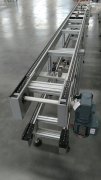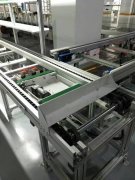Conveyor common fault
One, the belt running deviation
In order to solve this kind of fault point to pay attention to the size precision of installation and daily maintenance. Run a variety of reasons, according to the different reasons for the difference between treatment.
1. Adjust the carrying idler group in central of the whole belt conveyor belt conveyor belt running deviation can be adjusted when the position of the roller set to adjust the running deviation; When making roller set of mounting holes are processed to grow on both sides of the hole, in order to adjust. Specific adjustment method, the specific method is the belt deviation which side, which side of the roller group moved forward in the direction of the belt to go forward, backward or the other side.
2. Install the self-aligning roller group. Self-aligning roller group has a variety of types such as intermediate shaft type, four connecting rod type, the vertical roll type etc. Its principle is to use blocking or roller rotation in the horizontal plane directions or resulted from lateral thrust belt automatically to achieve the purpose of running deviation of the belt can be adjusted. Generally in a relatively short time or the total length of the belt conveyor belt conveyor two-way runtime USES this method is reasonable, reason is the short belt conveyor is more likely to run partial, and not easy to adjust. The long belt conveyor had better not use this method, because the use of self-aligning roller group will produce certain effect on the service life of the belt.
3. Adjust the driving drum and redirection roller position. And the adjustment of the redirection roller driving drum is an important part of the belt running deviation adjustment. Because of a belt conveyor are at least two to five drum, drum of all installation location must be perpendicular to the centerline of the direction of the length of the belt conveyor, if excessive deflection must be wandering. The adjustment method and similar roller group. To head to the right side of the drum drum, such as belt running deviation, the bearing should move forward, on the right side of the belt to the drum of the left side of the wandering, is on the left side of the bearing should be moving forward, can also be on the left side of the corresponding bearing seat back or on the right side of bearing seat back. The tail roller adjustment method is contrary to the head roller. Adjustment method. After repeated adjustment until the belt to the ideal position. Best before adjusting drive or redirection roller installed its position accurately.
4. Zhang JinChu adjustment. Belt of JinChu adjustment is belt conveyor running deviation of a very important link. Two upper heavy hammer zhang JinChu redirection roller besides belt length should be perpendicular to the direction should be perpendicular to the gravity vertical, which ensure the shaft centerline. Using spiral tension or hydraulic tensioning oil cylinder, the two tension roller bearing should translation at the same time, to ensure that the cylinder axis and the vertical belt longitudinal direction. The specific belt running deviation adjustment method and the roller of similar.
5. Reprint point blanking position influence on belt running deviation. Transfer point material blanking position has a very large effect on the belt running deviation, especially in the two belt conveyor in the horizontal plane projection into vertical impact is bigger. Usually should consider transfer points up and down two relative height of belt conveyor. Relative height is lower, the greater the horizontal velocity component of the material, on the lower belt lateral impact is bigger, the material is difficult to center at the same time. Make the materials on the belt cross section deflection, eventually led to the belt running deviation. If the material slants to the right, the belt running deviation, and to the left and vice versa. In the design process should be as much as possible to increase the two relative height of belt conveyor. In the limited space of up and down movement of bulk material conveying machinery funnel, feed trough should seriously consider such a form and size. General feed trough of the width of about two-thirds of the width of the belt is more appropriate. To reduce or avoid the belt running deviation can increase the keep-off plate block material, change the direction of the whereabouts of the material and location.
6. The bidirectional adjustment of deviation of belt conveyor running operation. Two-way running of belt conveyor belt running deviation adjustment than one-way belt conveyor running deviation of a much more difficult, in the concrete adjustment should be first in one direction, and then adjust the other direction. Adjustment should observe carefully when belt movement direction and trend of running deviation, the relationship between one by one. The emphasis should be on the adjustment and haul driving drum drum, followed by the adjustment of the roller and the material of blanking point adjustment. Belt should be paid attention to and should make the belt when vulcanization joint force uniform, and the section length direction when using leading chain traction force on either side of the equal as much as possible.
Second,. Material processing
Belt conveyor and material is a common problem, reason is various. But the key to strengthen the daily maintenance and maintenance.
1. The transfer point of scattered points and reprinted material is mainly in the hopper, guide chute, etc. Such as serious overload belt conveyor, belt conveyor guide chute keep-off rubber apron is damaged, guide chute in steel design located away from rubber apron belt long make the material out of the feed trough. The above situation can be in control on the carrying capacity, strengthen the maintenance is resolved.
2. The concave section of the belt hung up when the concave section of the belt and material range when the concave section of the radius of curvature is small belt causes impending, the belt into a groove situation changes, because the belt has left the grooved roller group, generally smaller groove Angle, make out part of the material. In the design phase, therefore, should be used as much as possible the larger concave curvature radius to avoid such situation happen. As in the portable mechanical loading machine, material piling and taking machine equipment in order to shorten the vehicle and the concave section designed without arc transition interval, when the belt width is easier to choose redundancy, a hour and materials.
3. When running deviation of belt running deviation and material because of belt at run time when the two edge height changed, one side is high, but on the other side is low, the material from one side of the lower and the processing method is to adjust the belt running deviation.
The installation of belt conveyor
Before the installation:
Transfer tower and the silo to again after completion of installation of belt conveyor.
Note:
All the installation of belt conveyor and adjustment shall be carried out in accordance with the geological parameters and drawings.
Installation work:
line
Check the civil construction, check the foundation bolt and embedded steel plate
Check the position of the parts of belt conveyor
According to the anchor bolt installation truss
To install and adjust equipment (including upper and lower roller, wiper, driving device, etc.)
Install the tape winding machine
Install expansion head
Installation guide chute
Install the tension device
Install all electrical part of the stent
Adhesive tape cutting and sulfide connection
Installation before the end of the work
Check:
On the tape before installation check belt conveyor and drawings and geological parameters.
Electrical parts:
Installation of cable pipe
Install the limit switch, protection device, electric control cabinet, etc
Install lamps
Laying cable
Connect the electric wire
Paint:
Damaged part in the cleaning paint and carried out in accordance with the specification requirements for spray paint.
Lubricating oil:
As stipulated in the lubricating oil operations manual program will add grease or oil added to the following equipment: reducer, coupling, crane, bearing, motor bearing, etc.
- 皮带输送机撕裂故障及其防护措施分析2018-11-15
- 滚筒输送机的发展及现状研究(二)2018-11-15
- 滚筒输送机的发展及现状研究(一)2018-11-15
- 皮带输送机固体物料称重给料系统设计初探2018-11-01
- 摩擦式积放滚筒输送机装置的设计2018-11-01
- 滚筒输送机PLC控制技术在空调生产系统中的应用2018-11-01




